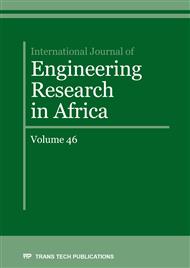[1]
ISO/ASTM International, Standard Terminology for Additive Manufacturing – General Principles – Terminology (ISO/ASTM 52900:2015(E)), (2016), 1-9.
DOI: 10.31030/2631641
Google Scholar
[2]
P.K. Farayibi, T.E. Abioye, A study on the awareness level of additive manufacturing technology in south-western Nigeria, African Journal of Science, Technology, Innovation and Development, 9, (2017), 1-6.
DOI: 10.1080/20421338.2017.1298231
Google Scholar
[3]
P.K. Farayibi, M.S. Bakare, T.E. Abioye, P.K. Oke, Potential Opportunities of Additive Manufacturing Technology in Nigeria, Journal of Engineering and Technology Research, 4, (2015), 57-69.
Google Scholar
[4]
P. Komamicki, A Review of Fused Deposition Modeling Process Models, Proceedings of the 13th International Scientific Conference: Computer Aided Engineering, Lecture Notes in Mechanical Engineering, (2017), 241-247.
DOI: 10.1007/978-3-319-50938-9_25
Google Scholar
[5]
P. K. Farayibi, T. E. Abioye, Additive manufacture of TiB2/Ti-6Al-4V metal matrix composite by selective laser melting, International Journal of Rapid Manufacturing 8(3), (2019), 259-270.
DOI: 10.1504/ijrapidm.2019.10020263
Google Scholar
[6]
N. Guo, C.L. Ming, Additive Manufacturing: Technology, Applications and Research Needs, Frontiers of Mechanical Engineering, 8, (2013), 215-243.
Google Scholar
[7]
Y.R. Kumar, C.S.P. Rao, T.A.J. Reddy, A robust process optimisation for fused deposition modelling, International Journal of Manufacturing Technology and Management, 14, (2008), 228-245.
DOI: 10.1504/ijmtm.2008.017497
Google Scholar
[8]
S. Song, A. Wang, Q. Huang, F. Tsung, Shape Deviation Modeling for Fused Deposition Modeling Processes, IEEE International Conference on Automation Science and Engineering, Taipei, Taiwan, August 18-22, (2014), 758-763.
DOI: 10.1109/coase.2014.6899411
Google Scholar
[9]
M. Shahrain, T. Didier, G. Kheng-Lim, A. J. Qureshi, Fast Deviation Simulation for Fused Deposition Modeling Process, Procedia CIRP, 43, (2016), 327-332.
DOI: 10.1016/j.procir.2016.02.004
Google Scholar
[10]
R. Rezaie, M. Badrossamay, A. Ghaie, H. Moosavi, Topology optimisation for fused deposition modelling process, Procedia CIRP, 6, (2013) 521-526.
DOI: 10.1016/j.procir.2013.03.098
Google Scholar
[11]
S. Rahmati, E. Vahabli, Evaluation of analytical modelling for improvement of surface roughness of FDM test part using measurement results, International Journal Advanced Manufacturing Technology, 79, (2015), 823-829.
DOI: 10.1007/s00170-015-6879-7
Google Scholar
[12]
A. Deshpande, A. Ravi, S. Kusel, R. Churchwell, K. Hsu, Interlayer thermal history modification for interface strength in fused filament fabricated parts, Progress in Additive Manufacturing, (2018),.
DOI: 10.1007/s40964-018-0063-1
Google Scholar
[13]
V. B. Nidagundi, R. Keshavamurthy, C. P. S. Prakash, Studies on Parametric Optimization for Fused Deposition Modelling Process, Materials Today: Proceedings, 2, (2015), 1691-1699.
DOI: 10.1016/j.matpr.2015.07.097
Google Scholar
[14]
U. K. Zaman, E. Boesch, A. Siadat, M. Rivette, A. A. Baqai, Impact of fused deposition modelling (FDM) process parameters on strength of built parts using Taguchi's design of experiments, The International Journal of Advanced Manufacturing Technology, (2018),.
DOI: 10.1007/s00170-018-3014-6
Google Scholar
[15]
M. Srivastava, S. Rathee, Optimisation of FDM process parameters by Taguchi method for imparting customised properties to components, Virtual and Physical Prototyping, (2018),.
DOI: 10.1080/17452759.2018.1440722
Google Scholar
[16]
S. Verma, V. Chaturvedi, Multiresponse Optimisation of Fused Deposition Modelling Process Using Utility Based Taguchi Approach, Journal of Advanced Manufacturing Systems,.
DOI: 10.1142/s0219686718500312
Google Scholar
[17]
P. K. Farayibi, Multi-Objective Optimisation of Laser Deposition of Metal Matrix Composites for Surface Coating Using Principal Component Analysis, International Journal of Engineering Research in Africa, 40, (2018), 9-21.
DOI: 10.4028/www.scientific.net/jera.40.9
Google Scholar
[18]
S. Farah, D. G. Anderson, R. Langer, Physical and mechanical properties of PLA and their functions in widespread applications – A comprehensive review, Advanced Drug Delivery Reviews, 107 (2016), 367-392.
DOI: 10.1016/j.addr.2016.06.012
Google Scholar
[19]
P. K. Farayibi, Laser Cladding of Ti-6Al-4V with carbide and boride reinforcements using wire and powder feedstock, PhD thesis, University of Nottingham, Nottingham, United Kingdom, (2014).
Google Scholar
[20]
O.O. Ojo, E. Taban, Hybrid multi-response optimization of friction stir spot welds: failure load, effective bonded size and flash volume as responses, Sadhana, 43 (2018), 1-13.
DOI: 10.1007/s12046-018-0882-2
Google Scholar


